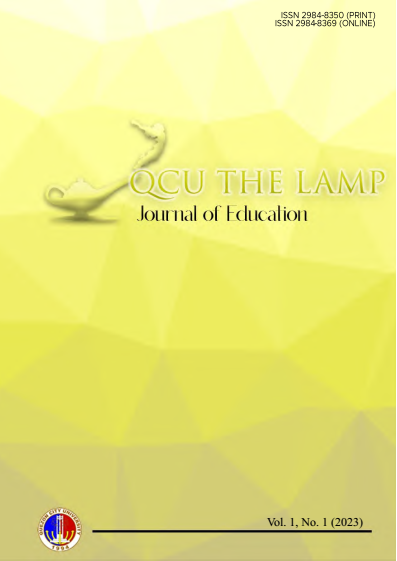Students’ Engagement in Online Learning Amidst COVID-19 Pandemic
DOI:
https://doi.org/10.64807/8vnz6z50Abstract
The Philippine school system has welcomed flexible learning and made adaptations to allow for remote instruction via digital platforms since the COVID-19 pandemic dramatically switched traditional study to online learning. QCU launched complete online learning in 2020–2021, 2021–2022, and blended learning in 2022–2023.Online learning was not widely accepted before the pandemic. Thus, researchers want to know how much students learned online during the pandemic. The study also gives teachers, university policymakers, and designers ideas for student engagement strategies to improve academic performance. This also makes accreditation and benchmarking data more accessible.Since online students rarely interact with the institution, Martin and Bolliger stress student engagement. Newmann, Wehlage, and Lamborn defined student engagement as “the student’s psychological interest in and effort towards obtaining, comprehending, or mastering the knowledge, skills, or crafts required for academic performance.”How engaged are online students? Does student engagement affect academic performance? A descriptive cross-sectional survey was chosen. Focus group discussions and interviews confirmed, explained, and triangulated the investigation’s findings.This study involves QCU students enrolled in the second semester of the Academic Year 2022–2023. A total of 657 students responded to the invitation to answer the questionnaire. A Shapiro-Wilk’s test and a visual inspection of their histograms and normal Q–Q plots showed that the respondents’ midterm general weighted average was not normally distributed. However, the distributions of Likert scores for the Online Classroom Student Engagement Scales (OCSES) were approximately normal for all the indicators.Students’ overall level of engagement revealed a mean score of 3.37, which was interpreted as moderate engagement. Among the indicators, assignment activity was the highest. Online student engagement does not have much effect on the midterm grades of the students except on assignment activity, which usually requires a higher level of active engagement by the students.In general, students would be more engaged in learning when they are given activities or tasks that involve deeper learning. Therefore, it is recommended to provide tasks, activities, discussions, and interactions that involve deeper learning, understanding, or analysis from the students.
Keywords:
Academic performance, COVID-19 pandemic, Traditional learning, Flexible learning, Online learning, Student EngagementReferences
Amora, J. T., Jaca, C. A. C., & Atanacio, R. P. (2016). Student engagement and college experience as mediators of the relationship between institutional support and academic performance. Revista Digital de Investigación Lasaliana, 12, 15–30. https://www.researchgate.net/publication/303328318_Student_Engagement_and_College_Experience_as_Mediators_of_the_Relationship_Between_Institutional_Support_and_Academic_Performance
Chen, J., Chen, H., & Chen, G. (2020). Can engagement in learning enhance tourism undergraduates’ employability? A case study. The International Journal of Interdisciplinary Social and Community Studies, 15(2), 1-15. https://doi.org/10.1177/0020720920930349
Dixson, M. (2015). Measuring student engagement in the online course: The online student engagement scale (OSE). Online Learning, 19(4), 1–11. https://doi.org/10.24059/olj.v19i4.561
Great Schools Partnership. (2016). Student engagement. The Glossary of Education Reform. https://www.edglossary.org/student-engagement/
Khan, R. A., Atta, K., Sajjad, M., & Jawaid, M. (2021). Twelve tips to enhance student engagement in synchronous online teaching and learning. Medical Teacher, 44(5), 601–606. https://doi.org/10.1080/0142159X.2021.1925340
Magsambol, B. (2021, May 22). CHED: There’s no going back, ‘flexible learning’ will be new norm. Rappler. https://www.rappler.com/nation/ched-says-flexible-learning-new-norm/
Mandernach, J. (2012, February). Indicators of engagement in the online classroom. Online Classroom, 10–12. https://www.facultyfocus.com/articles/online-education/indicators-of-engagement-in-the-online-classroom/
Manning-Ouellette, A., & Black, K. (2017). Learning leadership: A qualitative study on the differences of student learning in online versus traditional courses in a leadership studies program. The Journal of Leadership Education, 16(2), 164–180. https://doi.org/10.12806/V16/I2/R1
Martin, F., & Bolliger, D. U. (2018). Engagement matters: Student perceptions on the importance of engagement strategies in the online learning environment. Online Learning, 22(1), 205–222. https://doi.org/10.24059/olj.v22i1.1092
Meyer, K. A. (2014). Student engagement in online learning: What works and why. John Wiley & Sons. https://doi.org/10.1002/aehe.20018
Perry, E. H., & Pilati, M. L. (2011). Online learning. New Directions for Teaching and Learning, 128, 95–104. https://doi.org/10.1002/tl.470
Splendor, C. N., & Chikeme, P. C. (2020). A descriptive cross-sectional study: Practical and feasible design in investigating health care-seeking behaviors of undergraduates. In SAGE Research Methods Cases: Medicine and Health. SAGE Publications. https://doi.org/10.4135/9781529742862
Standards for Educational and Psychological Testing (US), American Educational Research Association, American Psychological Association, & National Council on Measurement in Education. (2014). Standards for educational and psychological testing. American Educational Research Association.
Torrefranca, E. R. (2020). Survey on the online tools readiness of QCU faculty and students [Unpublished manuscript].
Downloads
Published
Issue
Section
License
Copyright (c) 2025 Prof. Edward R. Torrefranca, Dr. Sheryl May E. Ramos, Prof. Mary Joy D. Vifias (Author)

This work is licensed under a Creative Commons Attribution 4.0 International License.
All articles published in QCU Journals are made available under the Creative Commons Attribution 4.0 International License (CC BY 4.0).
This license allows for:
- Sharing – copying and redistributing the material in any medium or format.
- Adapting – remixing, transforming, and building upon the material for any purpose, including commercial use.





